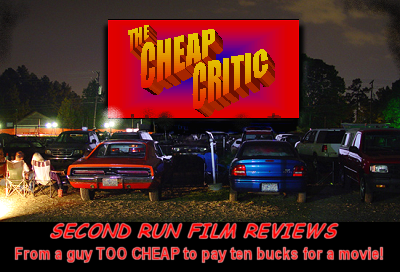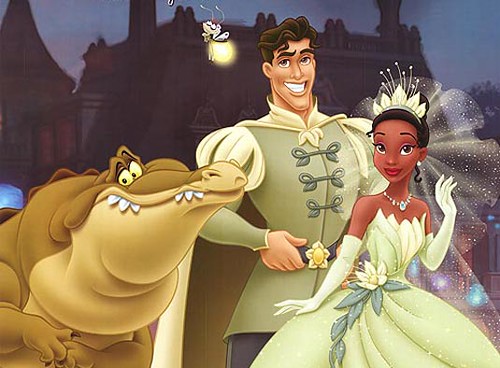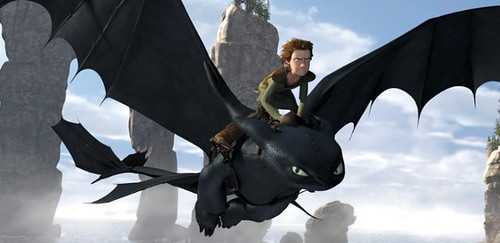
I've been interested in the competition between Disney and SKG Dreamworks ever since Jeffrey Katzenberg was booted from the helm at Disney in the early 1990s, teamed up with a Steven Spielberg and David Geffin to form SKG studios, and started to crank out competitors for everything that had been in Disney's pipeline at the time that he left the company. At first, Dreamworks' animated products were simply tit-for-tat responses to Disney -- Disney was about to release Toy Story II and Dreamworks rushed out Small Soldiers, Disney's A Bugs Life was answered with Dreamworks' Antz -- and in all cases the Dreamworks product just wasn't quite as good. But after a while Dreamworks Animation developed their own pipeline and started to make something besides bizarro Disney films and their product began to improve -- a gradual improvement that has continued until their best work now offers real competition for Katzenberg's one-time employer.
Their latest animated offerings offer a case in point: Disney's Princess and the Frog and Dreamworks Animation's How to Train Your Dragon show both studios in action. Here are my impressions:
The Princess and the Frog

In The Princess and the Frog, Disney returns to hand-drawn animation after a long series of computer generated and/or computer assisted animated features. Computer animation has improved in recent years and has reached the point where there is no compelling reason to prefer hand-drawn animation over the stuff done with computers. But the hand drawn product does have a different look and, in an industry where most animation is done on computers, the hand drawn animation in The Princess and the Frog is, at the same time, nostalgic and oddly fresh; it is beautifully drawn and animated, especially in the sequences at the beginning and the end that evoke the grace and charm of turn-of-the-century New Orleans, and in several fantasy sequences that are homages to artist Aaron Douglas. (Douglas was a luminary of that outpouring of African-American art, music and literature in the 1920s and -30s that was known as the Harlem Renaissance).
Jazz is one of the themes that runs through the film and the plot is a jazzy variation on the story of the princess whose kiss frees a prince from the enchantment that turned him into a frog. In this version, our heroine, Tiana, far from being a princess, is the daughter of a working-poor black family -- her mother works as a seamstress for the richest family in town (the La Bouffs) and her father has passed away leaving her his recipe for gumbo and his dream of opening a restaurant. Opposite her is prince Naveen, (who really is a prince.) He is a charming, carefree but largely useless vagabond who would rather be a musician than a prince, and has gotten himself turned into a frog by hanging around the sketchy parts of town where he ran into an ambitious voodoo man. They meet at at a party thrown by Tiana's friend, spoiled but good-hearted Charlotte La Bouff, who is determined to marry the prince, unaware that the handsome figure she is wooing is an impostor, or that the real prince, in frog form, is upstairs hectoring Tiana for a kiss to break his enchantment. Tiana's role as the "princess" in the scene comes from the fact that she has put on one of Charlotte's princess costumes when her own dress had been damaged in one of Disney's obligatory slapstick sequences involving frenetic action and messy food.
From there the story unfolds pretty much as you would expect: Prince Naveen, when his persistence pays off and he is rewarded with a reluctant smooch, is not turned back into himself (possibly because Tiana is not a real princess) but instead, Tiana is turned into a slightly cuter, but equally green frog, and hilarity and adventure ensue.
There is a lot to like about The Princess and the Frog. For one thing, it avoids several obvious cliches. Tiana is Disney's first black "princess" but the film is not at all about her race, and Tiana's best friend, Charlotte, is white, very rich and very spolied but also good-hearted, loyal and generous. There is a wonderful sequence where Tiana rides home on a trolly from the La Bouff's mansion to her family's small house in a poor black neighborhood. The contrast between rich and poor, white and black is quite clear but is drawn with such a light, graceful touch that, rather than showing us an unfair world, we see the gulf that transcendent friendship can span. Disney could easily have dislocated their collective shoulders, patting themselves on the back for completing their set of racially and ethnically diverse princesses but they didn't. Anika Noni Rose and Bruno Campos were very good as the voices of Tiana and Prince Naveen and the other voice actors were all fine. As I mentioned above, the art direction and animation were wonderful and the music is sprightly, if slightly unmemorable.
That said, The Princess and the Frog is not without its problems. It struggles to decide what sort of film it wants to be. It is set in New Orleans early in the last century, during the birth of the jazz culture on which so much of our idea of the cultural life of the city centers, but spends very little time there. Instead, for most of the middle of the film it is bogged down in the Louisiana swamps where our froggy hero and heroine cavort with an all-singing, all-dancing cast of talking animals, splashing their way through rather-too-many musical numbers in an anachronistic folksy musical style that has little to do with turn of the century New Orleans -- or with Louisiana's Cajun culture -- and very much to do with Disney's desire to include a rehash of popular bits from The Jungle Book.
In these sequences a talking, trumpet-playing alligator named Louie plays the dual roles of Baloo and King Louie from the Jungle Book. This digression into the bayou, I think, was a mistake. New Orleans in the 1920s was a sufficiently musical and magical place for their purposes; a lot more could have been done with New Orleans, its culture and the emergence of Jazz; the screenwriters should not have wandered off into the swamp.
The countless procession of talking animals tends to distract from the magical element of Naveen's transformation. When Tiana first meets him her reaction is "Eeek! A talking frog!" Which is fine and fits in the rather naturalistic portrayal of Turn of the Century New Orleans. But then it's "Eeek. A talking alligator" and "eek, a talking firefly" and "...eek, a ... oh, never mind." We find ourselves in a world where all animals talk and Tiana, apparently, was simply unobservant enough to grow up without noticing.
The Princess and the Frog is very much worth seeing. It is, in fact, a very good film but it misses being a great film through the pacing problems and the stylistic discontinuities introduced when ill-fitting bits of obligatory Disney formula was jammed into a movie that could have stood on its own. Pity, that, but still a good effort overall.
Odd aside: The Teleospouse volunteers at the North Carolina Museum of Art where she gives tours. She immediately recognized the Aaron Douglas inspired sequences although it took her until after the film was over to remember his name. (In the film look for our heroine's daydreams of the restaurant she wants to open someday.) The NCMA has a number of works by Douglas and the one I remember best is a striking gouache and pencil illustration he did for Paul Morand's book "Black Magic" in 1929. The illustration is entitled "Charleston" and it features a black saxophonist being admired by a languid white woman. It also shows a pair of clutching hands in the foreground and a hangman's noose between the man and the woman. Taken all together these elements suggest that the sexual tension between the black musician and the white woman was a dangerous thing. It makes an interesting and ironic contrast to the rather less edgy relationship Disney shows between black Tiana and apparently white Prince Naveen (a musician) in a story with a very similar time and setting.
There is a small image of Douglas' "Charleston" on one of the middle pages of this brochure from a show at the Spencer Museum of Art at The University of Kansas, Lawrence.
How to Train Your Dragon

I will have less to say about Dreamworks Animation's How to Train Your Dragon, mostly because it is the better film of the two and I will find scarcely anything to criticize. It is, perhaps, a bit less ambitious than The Princess and the Frog but it does what it sets out to do effortlessly. I complained that some of the obligatory elements seemed to have been wedged into Princess and the Frog as an ill-fitting afterthought but when I saw How to Train Your Dragon it was only after the film was over, as I took stock mentally of what I had seen, that I noticed that all of the obligatory elements of a kid's adventure film had been present: Geeky kid who is ignored by adults and made fun of by other kids turns out to have the stuff of heros? Check. The cute, popular, tomboy, on whom our hero has a bit of a crush, is the first to notice his change in status? Yep. 3D eye candy? You betcha. Waterslides, roller coasters or swoopy flying scenes? Only the latter, but plenty of it. Animals that are cute and scary at the same time? Yes. Giant monsters? Ohhh yes. Unusual pets? Yep. Lots of stuff cribbed from Harry Potter? Of course. Action sequences with risk of death and dismemberment? Roger that. Death and diememberment? Yes, both actually; I don't remember any main characters that die but the film pays off big time in the dismemberment department.
The film opens with views of a picturesque viking village perched atop rugged cliffs by the sea. In voiceover our hero, Hiccup son of Stoic, sets the scene for us:
This is Berk. It's twelve days north of Hopeless and a few degrees south of Freezing to Death. It's located solidly on the Meridian of Misery. My village. In a word? Sturdy, and it's been here for seven generations, but every single building is new. We have fishing, hunting, and a charming view of the sunset. The only problems are the pests. You see, most places have mice or mosquitoes. We have... dragons.
I won't go to the trouble of summarizing the plot here. From Hiccup's introduction and my list of obligatory kid's adventure film elements you can work out all you need to know about the story, although it is tempting to offer the further suggestion that you can consider How to Train your Dragon to be a sequel, of sorts, to Beowulf, done as a kid's coming of age tale. Gerald Butler, who plays Hiccup's dad played Beowulf in the 2005 film Beowulf and Grendel and he seems to have brought much of the situation to this film with him.
So please do see How to Train your Dragon, if you get a chance. It is quite the best kid's film in years, and saying that is to undersell it because you don't have to be a kid to enjoy it. It is wonderfully written with engaging characters and real excitement. The 3D animation is top notch and adds to the enjoyment without becoming the only reason to see the film -- catch it in 3D if you can (it is well worth the couple of extra bucks) but don't hesitate to watch a flat print if that is all that's available. It's a lovely film. I recommend it.
On balance, I have to hand the win to Dreamworks Animation this time. Disney's film was a worthy effort but they seem a bit off their game. Score one for Katzenberg.
I am, once again, semi-cheating on the "Cheap Critic" theme for these two films since I paid full price to see How to Train your Dragon in 3D, but I did see The Princess and the Frog at our local second-run theater. This makes the average ticket price about six bucks: more than I like to pay but not enough to endanger my cheapskate creds.
